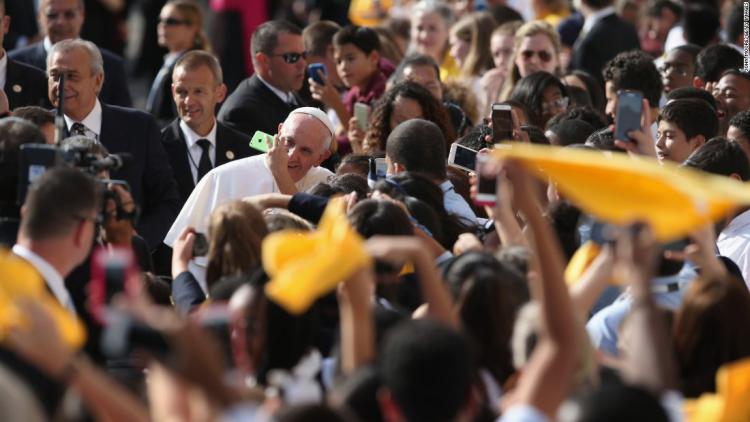Following the Pope in Under 140 Characters

Last month, Pope Francis made his long-awaited appearance in the U.S. and everyone went #crazy. When the man, the myth, the legend himself rolled up in his Popemobile, not a single American with a smartphone in their hand could say they missed the memo. It’s been more than seven years since the Pope last visited America in 2008, and social media turned this visit into something vastly different than any U.S. trip in the past.
Yes, Pope Francis is active on Twitter, @Pontifex. There are actually nine accounts in total; the most popular is the Spanish @Pontifex_es. The accounts, activated by Pope Benedict in 2012, were created with the hope of drawing in the Roman Catholic Church’s 1.2 billion followers online, particularly younger generations.
Pope Francis has remained active on the Twitter accounts, which all post from a single computer in the Vatican. The words are his own and are posted daily with his approval in nine different languages by delegated officials. Most tweets are centered around prayer or reminding his followers to thank God each day. In the six months leading up to this 2015 U.S. trip, English-speaking followers increased by 1.5 million, for a current total of just under 7.5 million.
Pope-centric social media output has not been traveling down a one-way street. A list of stats compiled by Adweek just about halfway through the Pope’s three-city East Coast jaunt speak to the extent of all the buzz. As of Sept. 25, 22 percent of all digital content engagement around Fiat was related to the pope, "Pope Francis" had been mentioned in 177,633 tweets, and the hashtag #PopeInDC appeared 117,765 times, while the New York City counterpart, #PopeinNYC, had been used 110,169 times.
To accompany the hashtags, and a slew of selfies with the Pope, big time social media players provided users with even more tools for spreading their affection. The Popemoji app for iOS and Android allowed users to finish off posts and texts with emojis of Pope Francis eating a philly cheesesteak or standing next to the Statue of Liberty. Snapchat joined the game too, releasing a, “They see me rollin” geofilter for the DC portion of his trip, featuring the Pope in his Popemboile. Pope Francis even made his way onto Tinder with this fake account created by a Philadelphia resident.
Snapchat geofilter | Photo: MashableAs amusing as Pope induced social media activity is, it saddens me a bit to think that the initial intents of Pope Francis in entering the Twitter world, to unite the Catholic Church’s followers, has not really panned out as predicted back in 2012. Again, according to Adweek’s compilation of stats mid-visit, sentiment around the Pope had been about 21 percent positive, 12 percent negative, and a significant 67 percent neutral. The high volume of tweets, posts, and snaps in the last few weeks allude to the commodification of religion, or at least this religious figure. Social media lends itself to exploiting trends, often using humor to gain validation and cyber-popularity in the form of a “like.”
On the last day of his tour at St. Charles Borromeo Seminary in Pennsylvania, Pope Francis delivered some fitting sentiments about our society obsessed with social media, "I would dare say that at the root of so many contemporary situations is a kind of radical loneliness that so many people live in today. Running after the latest fad, a like, accumulating followers on any of the social networks." Social media makes us lonely, and the Pope agrees.
With my heartfelt thanks. May the love of Christ always guide the American people! #GodBlessAmerica
— Pope Francis (@Pontifex) September 28, 2015
Despite all the jokes and selfies, his last tweet in the US was, in classic Pope-style, as tasteful as ever: “With my heartfelt thanks. May the love of Christ always guide the American people! #GodBlessAmerica."









